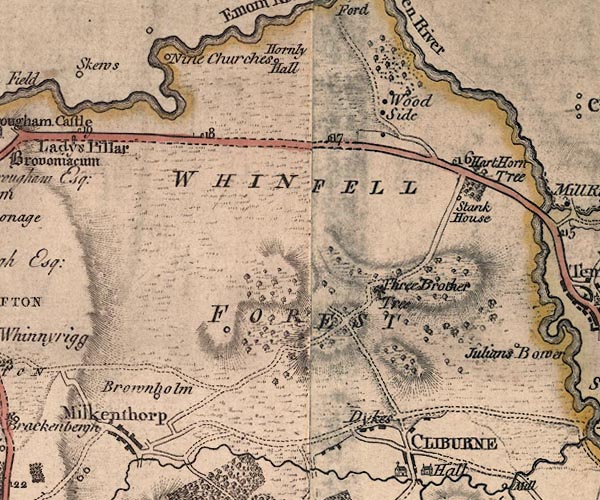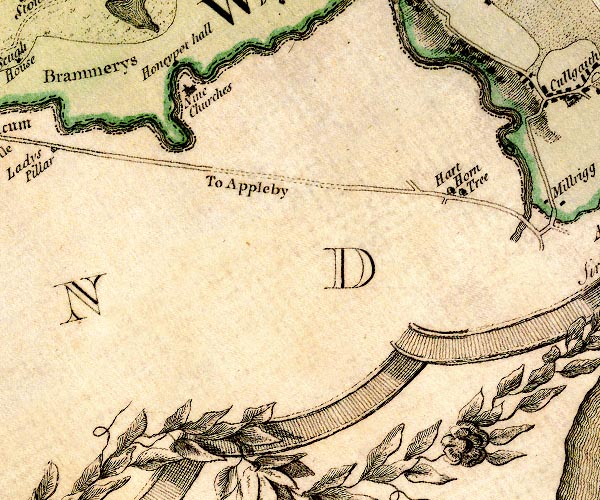




placename:- Hartshorn Tree
"Hartshorn Tree (Site Of)"
placename:- Hart Horn Tree
"... Hart-Horn Tree, where they shew'd us the head of a stag nail'd up against a tree, or rather shew'd us the tree where they said it was nail'd up, in memory of a famous chase of a stag by one single dog. It seems the dog (not a greyhound, as Mr. Cambden's continuator calls it, but a stanch buckhound, to be sure) chas'd a stag from this place, (Whitefield Park) as far as the Red Kirk in Scotland, which, they say, is sixty miles at least, and back again to the same place, where, being both spent, and at the last gasp, the stag strain'd all its force remaining to leap the park pales, did it, and dy'd on the inside; the hound, attempting to leap after him, had not strength to go over, but fell back, and dy'd on the outside just opposite; after which the heads of both were nail'd up upon the tree, and this distich made on them; the hound's name, it seems, was Hercules."
"Hercules kill'd Hart a Greese, / And Hart a Greese kill'd Hercules."
item:- stag; deer; hound; buckhound; Hercules; hawthorn
 goto source
goto source"..."
"In Whinfield Park, at the Borders of this County, is shewn a Hawthorn Tree, against which the Heads of a Stag and a Dog were formerly nailed up in Memory of a famous Chace: It seems a Dog (not a Greyhound, as Mr. Camden's Continuator calls it, but a staunch Buckhound) singly chased a Stag from this Park, as far as the Red Kirk in Scotland, which they say is 60 Miles at least, and back again to the same Place; where being both spent, the Stag exerting his last Force, leaped the Park Pales, and died on the Inside; the Hound attempting to leap after him, had not Strength enough to get over, but fell back and died on the Outside just opposite. The Heads of both were nailed upon the Tree, and underneath this Distich on them:"
"Hercules kill'd Hart-a-Greese"
"And Hart-a-Greese kill'd Hercules.[1]"
placename:- Hart Horn Tree

J5NY52NE.jpg
"Hart Horn Tree"
trees
item:- National Library of Scotland : EME.s.47
Image © National Library of Scotland
placename:- Hart Horn Oak
placename:- Hart's Horn Tree
item:- hunting; greyhound; Hercules; deer; Hart a Greese
 goto source
goto sourcePennant's Tour 1773, page 153 "If the Hart-horn oak exists, it escaped my notice. Mr. Brooke, Somerset Herald, told me he had seen an ancient tree in the road leading from Penrith to Appleby, not far from Lady's Pillar, said to be Hart's-horn Tree, which road is over part of Whinfel-park, that has been inclosed. It took its name from a pair of stag's horns nailed on it, in memory of a famous chace, in the years 1333 or 1334, between a greyhound named Hercules, and a stag. They are said to have run from this park to Red Kirk in Scotland, and back again: that the stag had just strength enough to leap over the pales, within which it died. Hercules, in attempting to follow, fell down, and died on the outside. - The horns of the stag were nailed on one of the oaks; and, in process of time, being lost in the growth of the tree, another pair were nailed on, and, to record this wonderful chace, the following lines were inscribed:"
""Hercules killed Hart a-greese,
"And Hart a-greese killed Hercules.""
"But Dr. Burn justly observed, that it is much more probable that the chace was to Nine Kirk, or the Church of St. Ninian, a place on the Eimot, within the verge of the forest, than to Red Kirk in Scotland, a distance so remote as to take away all credit from the relation."
placename:- Hart Horn Tree

D4NY52NE.jpg
"Hart Horn Tree"
2 trees
item:- Carlisle Library : Map 2
Image © Carlisle Library
placename:- Harthorn Oaks
 goto source
goto sourceAddendum; Mr Gray's Journal, 1769
Page 200:- "... Passed ... Harthorn-oaks, ... crossed the Eden and the Eamont ... [to] Penrith ..."
placename:- Hartshorn Tree
item:- deer; hound; Hercules; hunt
 goto source
goto sourcePage 3:- "..."
"I SHALL begin my observations at the Countess's Pillar, where likewise my plans commence: I shall, however, exceed this bound, to take notice of a very large Oak Tree in Whinfield-Park, called the Harts-horn Tree. Concerning this tree there is a tradition, confirmed by Anne Countess of Pembroke in her memoirs, that an hart was run by a single dog from this place to Red-Kirk in Scotland and back again: when they came near this tree the hart leaped the wall but the dog, worn out with fatigue, was unable to follow him, and died there; the hart, equally fatigued, could proceed no farther, and in this situation they were found by the hunters, the dog dead on one side of the wall, and the deer on the other. In memory of this remarkable chace, the hart's horns were fixed upon this tree, whence it obtained its name; and as all extraordinary events were in those days recorded in rhymes we find the following popular one upon this occasion, from which we learn the dog's name likewise:"
""Hercules kill'd Hart of Greece,
"And Hart of Greece kill'd Hercules.""
"This story appears to have been literally true, as the Scots preserve it without any variation, and add, that it happened in the year 1333 or 1334, when Edward Baliol King of Scots came to hunt with Robert de Clifford in his domains at Appleby and Brougham. I cannot, however, help thinking the Countess is mistaken in calling the dog a Grey-Hound, as he must have run upwards of 80 miles, even supposing the deer to have taken the direct road; and this no one, who is acquainted with the nature of dogs, can suppose a grey-hound capable of performing."
placename:- Harthorn Tree
item:- stag; Heartagreese; greyhound; Hercules
 goto source
goto sourcePage 159:- "..."
"... Hart-horn tree, ... borrowed its own [name] from a stag which was coursed by a single greyhound to the Red Kirk in Scotland, and back again to this place, where both being spent, the stag leapt the pales, and died on the other side, and the hound, attempting to leap, fell and died on this side. Both their heads were"
 goto source
goto sourcePage 160:- "nailed on the tree, and the dog's name being Hercules, they made this rhyme on them inscribed on a brass plate:"
"Hercules kill'd Hartagreese
And Hartagreese kill'd Hercules."
"But this seems all vulgar tradition, and for Red kirk we should rather suppose Nine kirks at Brougham a neighbouring parish; and before this there was a place in the park called Harthorn sike, perhaps from some large horns."
item:- hunting
 goto source
goto sourceGentleman's Magazine 1825 part 1 p.516 "Compendium of County History. - Westmorland."
"... WHINFELL, ... The hart's-horn tree which grew by the way-side near Hornby Hall had its name from a pair of horns hung up in it about 1333 or 1334, after a memorable chase. The stag was started by a grey-hound, and after chasing it to a considerable distance and back again, the stag vaulted the park paling, but instantly died. The dog, in attempting to clear it, fell backwards and expired. One of these horns were broken out of the tree in 1648, and the other in 1658. ..."
